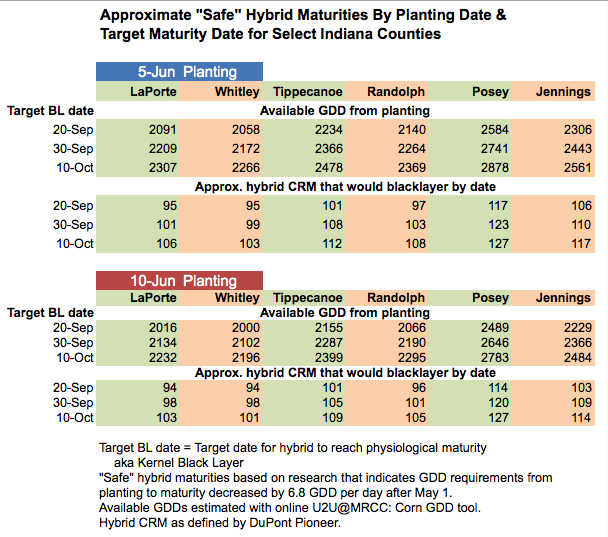23 May 2017
URL: http://www.kingcorn.org/news/articles_17/SafeMaturities-0523.html
Update on "Safe" Hybrid Maturities for Late Plantings
R.L. (Bob) Nielsen
Agronomy Dept., Purdue Univ.
West Lafayette, IN 47907-2054
Email address: rnielsen at purdue.edu
Twitter: @PurdueCornGuy
Time is running out for some Indiana fields not yet planted to their intended corn crop or those fields already planted to corn that now require replanting. Many fields are currently too wet to allow for planting. Forecast rains the remainder of the week and over the coming weekend threaten to keep corn planters out of some fields until early June.
There are two challenges with regard to choosing hybrid maturities to plant in early June in Indiana. One relates to whether the chosen hybrid maturity will mature safely (i.e., kernel black layer) before a killing fall freeze. The other is whether the chosen hybrid maturity will mature early enough to allow enough time for the grain to dry to acceptable harvest moistures.
In another, lengthier, article I describe the process for estimating �safe� hybrid maturities suitable for late planting (Nielsen, 2017). The purpose of this brief article is to simply offer a little more insight to the thought process.
As indicated above, the choice of the desired date to reach kernel black layer influences not only the estimate of available GDD from planting, but also the likely grain moisture loss (drydown) per day after maturity. If your primary objective is to simply mature the crop before a killing fall freeze in early to mid-October, then you can use a later maturity hybrid and take advantage of another couple weeks of GDDs. If you want the crop to mature in late September to take advantage of relatively better field drydown conditions, that will by necessity require planting an earlier relative maturity hybrid because of the fewer available GDDs. The difference in estimated "safe" relative hybrid maturities between the two decisions can be dramatic.
The accompanying table provides estimates of "safe" relative hybrid maturities for two planting dates (June 5 and 10) for six select counties across the state (different geographic locations) and three targeted crop maturity dates in the fall (Sept 20, Sep 30, and Oct 10). These estimates are based on the procedure described in my lengthier article (Nielsen, 2017).
Bottom line is that the time is approaching when the "safe" relative hybrid maturities for delayed corn planting will simply be too unadapted for most growers' liking, both from the lower yield potential perspective and typically unsatisfactory genetic disease resistance. Factor in the economics and crop insurance considerations (June 5 cutoff for full coverage, same for prevented planting with some policies), then the window for corn planting is beginning to close.

Fig. 1. Approximate "safe" corn hybrid maturities by planting date and target maturity date for select Indiana counties.
Related Reading
Nielsen, RL (Bob). 2017. Hybrid Maturities for Delayed Planting. Corny News Network, Purdue Univ, Agronomy Extension. URL: http://www.kingcorn.org/news/timeless/HybridMaturityDelayedPlant.html. Accessed May 2017.